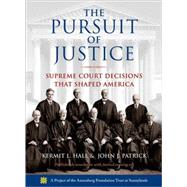The Pursuit of Justice Supreme Court Decisions that Shaped America
, by Hall, Kermit L.; Patrick, John J.- ISBN: 9780195311891 | 0195311892
- Cover: Hardcover
- Copyright: 12/1/2006
With a survey of the thirty Supreme Court cases that, in the opinion of U.S. Supreme Court justices and leading civics educators and legal historians, are the most important for American citizens to understand, The Pursuit of Justice is the perfect companion for those wishing to learn more about American civics and government. The cases range across three centuries of American history, including such landmarks as Marbury v. Madison (1803), which established the principle of judicial review; Scott v. Sandford (1857), which inflamed the slavery argument in the United States and led to the Civil War; Plessy v. Ferguson (1896), which memorialized the concept of separate but equal; and Brown v. Board of Education (1954), which overturned Plessy. Dealing with issues of particular concern to students, such as voting, school prayer, search and seizure, and affirmative action, and broad democratic concepts such as separation of powers, federalism, and separation of church and state, the book covers all the major cases specified in the national and state civics and American history standards. For each case, there is an introductory essay providing historical background and legal commentary as well as excerpts from the decision(s); related documents such as briefs or evidence, with headnotes and/or marginal commentary, some possibly in facsimile; and features or sidebars on principal players in the decisions, whether attorneys, plaintiffs, defendants, or justices. An introductory essay defines the criteria for selecting the cases and setting them in the context of American history and government, and a concluding essay suggests the role that the Court will play in the future.






